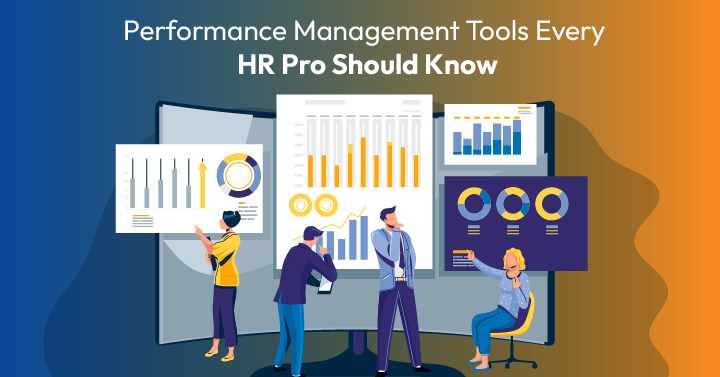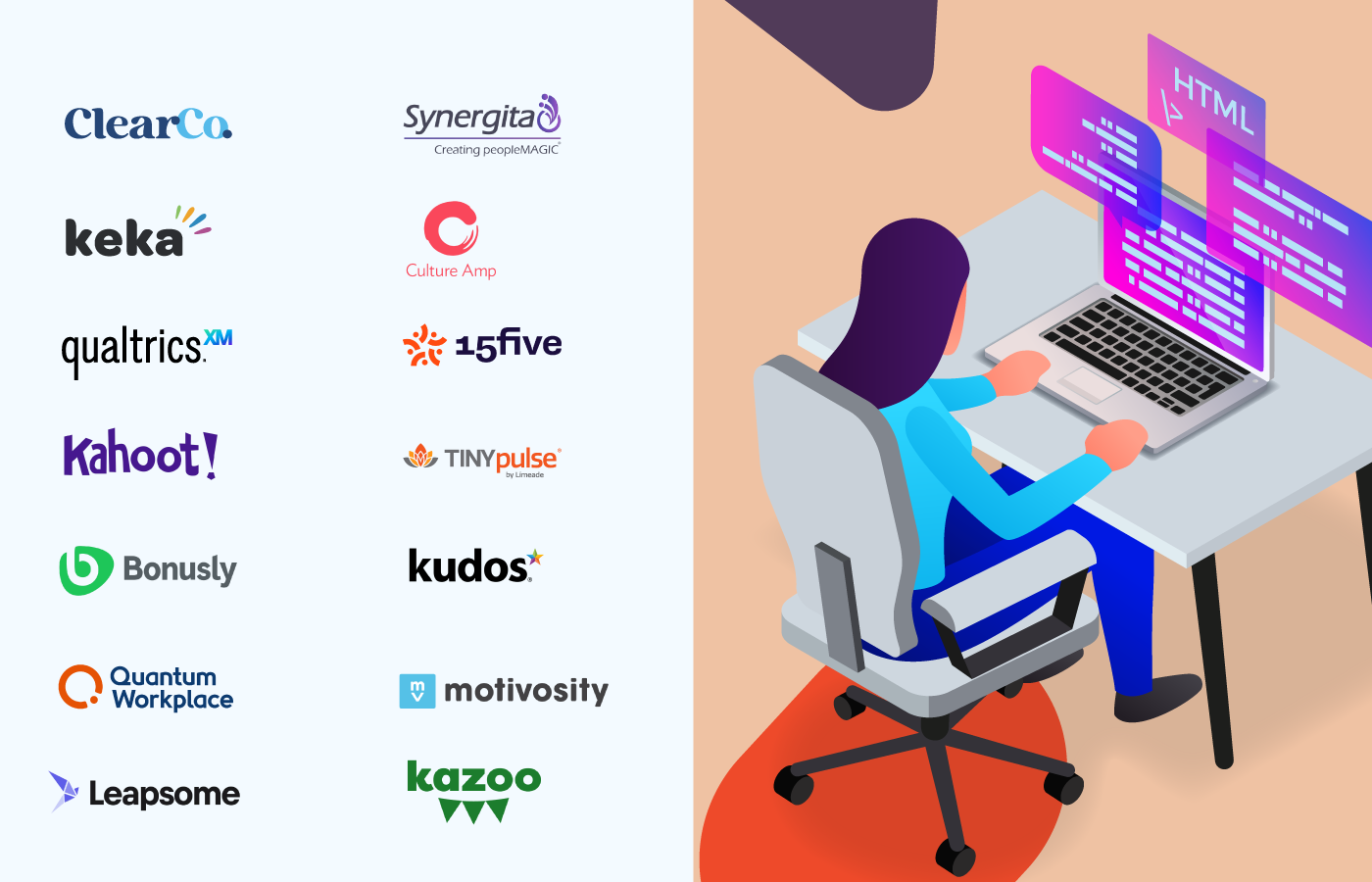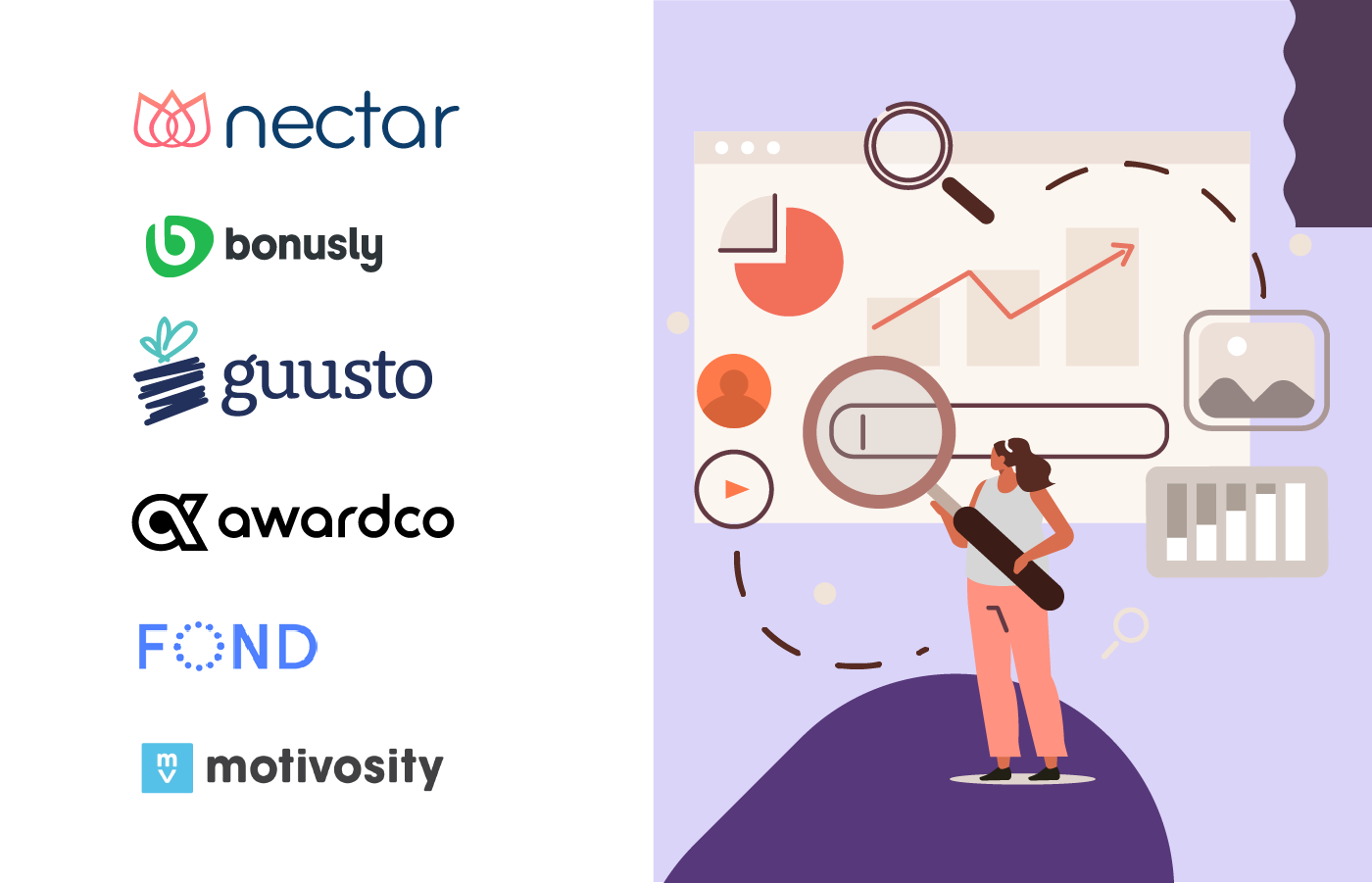Performance management tools are an excellent way to keep your teams on track. Whether as part of a broader HR offering or as standalone software, these solutions make it so much easier to get a continuously updated picture of which of your employees is leading the pack and which ones may need some additional training. In this article, we’re going to cover some of the most popular options on the market today.
To enhance your organizational growth, dive into our featured article on the top performance management tools that help monitor and optimize your team's performance.
Some are more specialized in task tracking, and others deal principally with learning and development (L&D), but all of them have a particular utility that can benefit your HR department.
1. What are Performance Management Tools?
Performance management tools are software that helps align company goals with individual objectives, assess productivity and streamline feedback processes. They enable managers to review their employees’ efficacy while also giving employees a concrete way to gauge their own success.
2. Importance of Performance Management Tools for HRs
One of the most important aspects of performance management tools is that they establish clear expectations for each individual member of staff. Once goals have been set, these can then be monitored through performance evaluations and 360-degree feedback. In order to help employees, meet their objectives, many performance management tools also include some form of L&D, so that everyone has the necessary skills to do an optimal job. Another secondary aspect can be a system to administer rewards and promote recognition, in order to encourage job satisfaction and enhance productivity.
3. 12 Best Performance Management Tools
| Leapsome | Best performance management tool for performance planning |
| Kallidus Perform | Best performance management tool for Learning and Development |
| Motivosity | Best performance management tool for rewards programs |
| Peoplebox | Best performance management tool for OKR setting and tracking |
| Monday.com | Best performance management tool for monitoring task completion rates |
| GoCo | Best performance management tool for automating feedback cycles |
| Mirro | Best performance management tool for dispersed teams |
| Connecteam | Best performance management tool for mobile-first design |
| PerformYard | Best performance management tool for flexible review structures |
| BambooHR | Best performance management tool as part of a complete HR solution |
| Grove | Best performance management tool for agile teams |
| Actus | Best performance management tool for scalability |
4. Selection Criteria for Performance Management Tools
4.1 UI
The user interface is how staff interact with the performance management tools. A user-friendly, intuitive UI translates into easy navigation and optimized workflows. A well-designed UI also reduces the need for extensive training, allowing employees to quickly learn and adapt to the new system.
4.2 Scalability
As a company grows, the software it uses needs to grow with it. Performance management tools that have scalability will be able to cope with larger staff sizes without diminished efficacy. A scalable tool is essential for long-term success, as it saves time and money on software updates and retraining.
4.3 Data storage
Performance management tools need to be able to store information on past appraisals and training undertaken. This makes it easier to spot any skills gaps and to check whether staff are improving their task execution. A robust data storage system also ensures that employee data is secure and easily accessible when needed.
4.4 Customization
Customization refers to the degree to which you can adapt a piece of software to your unique company processes. The more customizable a performance management tool is, the more bespoke you can make it to your business ethos. A customizable tool also ensures that the performance management system remains relevant as the company evolves.
4.5 Usability
Usability refers to how easy it is to use the performance management tool. Ideally, users should need minimal support to understand a program and its functions. A user-friendly tool also reduces frustration and the likelihood of errors, improving overall productivity and engagement.
4.6 Integrations with other apps
Purchasing business performance management tools that integrate with your existing software will lead to a more streamlined digital architecture and, therefore, greater efficiency. For example, a performance management tool that integrates with an HRIS (human resource information system) can automatically pull employee data, making it easier to track progress and identify performance trends.
4.7 Value for money
The employee management system you acquire should produce a good return on investment (ROI), saving you more money than it costs. A high-value performance management tool is an essential investment for any company looking to improve its performance management processes.
4.8 Data security
Data security is all about the safety measures a performance management tool has in place to ensure company and staff data is not compromised; this is important both for peace of mind and compliance reasons. A secure performance management tool is essential to maintaining trust with employees and protecting the reputation of the company.
5. Key Features
5.1 Review and feedback
Performance reviews and feedback programs are core performance evaluation tools. They enable companies to align goals with their employees and provide a framework for constructive growth.
5.2 Training and development programs
Training and development programs are usually managed through a learning management system (LMS). These can be used to create training plans and monitor progress.
5.3 Real-time reporting and analytics
Customizable data dashboards mean you can track the metrics that are important to you over time. These metrics can then be visualized as charts and graphs.
5.4 Performance plans
Once you’ve set goals, it’s helpful to break them down into smaller bites. Performance plans are essentially a roadmap toward attaining the bigger objectives.
6. 12 Best Performance Management Tools for HRs
6.1 Leapsome – Best performance management tool for performance planning
Leapsome is an all-in-one performance management platform that enables companies to set goals, manage performance, and provide feedback to employees.
What makes it unique?
People enablement platform Leapsome features five pillars: align (goal setting), perform (performance reviews), engage (pulse surveys and 360-degree feedback), learn (onboarding and skills development), and reward (compensation benchmarking and promotion recommendations) Managers can use the interface to set objectives and key results (OKRs) with their staff, before outlining the stages of a performance plan to make it happen. You can also create automated learning pathways either from your own internal materials or curated third-party content from Leapsome’s learning partner, GoodHabitz. Single sign-on (SSO) and encryption as part of security measures that ensure it is fully GDPR compliant. Integrations are available with common apps like Slack and MS Teams.
Key features -
- Goal setting and tracking
- Performance reviews
- 360-degree feedback
- Learning and development
- Analytics and reporting
Pros -
It covers a wide range of performance management needs.
Offers extensive customization options to fit unique company processes and workflows.
User-friendly interface and intuitive design that simplifies performance management tasks.
Cons -
Pricing can be expensive for smaller companies with limited budgets.
The platform may be overwhelming for companies that don't require all of the advanced features.
Some users report issues with customer support, including delayed response times.
Pricing -
Pricing starts from $8 per user per month and is based on company size and the number of modules you desire.
6.2 Kallidus Perform – Best performance management tool for Learning and Development
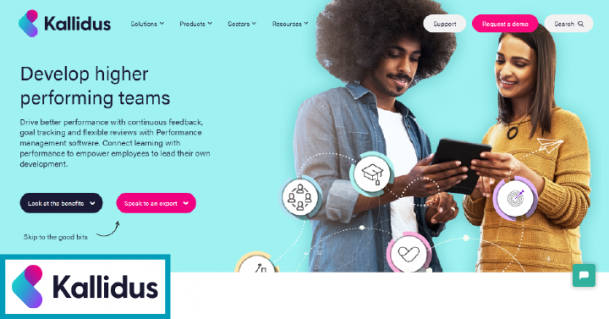
Kallidus Perform is a cloud-based performance management tool that helps organizations align their performance management strategies with business objectives.
What makes it unique?
Kallidus’ USP is its LMS, though it also has modules for applicant tracking and employee engagement. The Perform platform has a clear UI, which facilitates goal setting. Once the manager and their staff are aligned, these goals can then be assessed using qualitative and quantitative data from 360-degree performance reviews. The Perform module can be complemented with the Learn module, which features both off-the-shelf courses as well as the option to create bespoke training for your company. Plus, everything is mobile-optimized.
Key features -
- Goal setting and tracking
- Continuous performance management
- Real-time feedback
- Competency management
- Performance analytics and reporting
Pros -
- User-friendly interface that simplifies performance management tasks
- Offers mobile access for employees to track their progress and receive feedback
- Provides automated reminders and notifications to keep employees on track
Cons -
- The reporting functionality may be limited for some users
- The platform may not be as customizable as some other performance management tools
- The pricing structure may be costly for smaller companies
Pricing -
Pricing is available upon request.
6.3 Motivosity – Best performance management tool for rewards programs
Motivosity is an employee recognition and engagement platform that helps companies improve employee morale and productivity.
What makes it unique?
Motivosity specializes in rewards and recognition programs, which can be an important ancillary aspect of performance management tools and techniques. The solution is divided into four modules. Connect is the foundation of the software, designed to build a community in your company through peer-to-peer appreciation, personality profiles, interest groups, an organization chart, and a company feed with announcements. Recognize enables managers to give awards, gift vouchers, and even cash via the Visa-enabled ThanksMatters Card. Lead contains all the essential performance eval forms as well as succession planning and reporting charts. Finally, Listen is devoted to gathering staff feedback and assessing satisfaction through pulse surveys and eNPS tracking.
Key features -
- Employee recognition and rewards
- Employee feedback and communication
- Performance tracking and reporting
- Social recognition and peer-to-peer recognition
- Company culture analytics and reporting
Pros -
- User-friendly interface that simplifies employee recognition and engagement tasks
- Offers a variety of recognition and reward options, including gift cards and charitable donations
- Provides real-time feedback and communication between employees and managers
Cons -
- The platform may be expensive for smaller companies
- Some users have reported that the rewards catalog is limited or not relevant to all employees
- The performance tracking and reporting may be limited for some users
Pricing -
Motivosity’s Connect module is one of the few performance management tools free to use. The other modules range from $2-5 per user per month, though there are discounts for bundles.
6.4 Peoplebox – Best performance management tool for OKR setting and tracking
Peoplebox is a performance management and employee engagement platform that helps companies improve team performance and communication.
What makes it unique?
Peoplebox focuses on team alignment through the usage of OKRs. The simple-to-use system has tabs for company goals and individual goals, so everyone can monitor their own contributions in relation to overarching objectives. Managers, meanwhile, get a bird’s-eye view of strategic priorities to ensure everything stays on track. Integrating with Slack, Peoplebox prompts people when it’s time for them to write reviews, whether it’s a self-assessment, a peer review, or a manager’s evaluation. These are then fed into the dashboard, which also stores data on 1-on-1 meetings and brief check-ins. Complementing this is employee engagement software that tracks staff satisfaction.
Key features -
- Goal setting and tracking
- Continuous performance management
- Employee feedback and communication
- Real-time performance analytics and reporting
- Customizable workflows and templates
Pros -
- User-friendly interface that simplifies performance management tasks
- Offers customizable workflows and templates for performance management processes
Cons -
- Customer support may be slow or unresponsive for some users
- The platform may not offer as many features as some other performance management tools
Pricing -
Pricing starts at $7 per user per month for the Professional tier, including the OKR platform, task management, and standard integrations. Performance reviews and employee engagement tools are only available via the $15 Premium package.
6.5 Monday.com – Best performance management tool for tracking task completion rates
Monday.com is a project management and team collaboration platform that helps teams manage tasks, projects, and workflows.
What makes it unique?
Project management tool Monday.com has over 200 customizable readymade templates to help companies perform a range of operations. Using Monday.com, companies can establish SMART (specific, measurable, attainable, relevant, time-bound) goals. These can then be easily tracked through 1-on-1 catch-ups and task completion metrics that measure time to finish assignments. The software also has integrations for common apps like Excel, Slack, and Google Calendar, as well as feedback specialist SurveyMonkey and CRM Hubspot.
Key features -
- Customizable project templates
- Task tracking and management
- Team collaboration and communication
- Real-time project updates and progress tracking
- Time tracking and resource management
Pros -
- Offers team collaboration and communication features to facilitate teamwork
- Provides time tracking and resource management tools to help teams optimize their workflows
Cons -
- The reporting and analytics functionality may be limited for some users
- The platform may not be customizable to fit unique company processes or workflows
Pricing -
Pricing starts from $8 per person per month for unlimited boards and 5GB of storage, though there is a free option for up to two seats with 3 boards and 500MB storage.
6.6 GoCo – Best performance management tool for automating feedback cycles
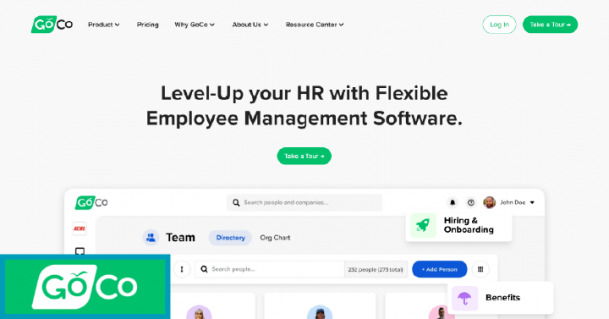
GoCo is an HR management platform that helps small and medium-sized businesses manage their HR processes, including onboarding, benefits administration, and performance management.
What makes it unique?
GoCo’s HR suite includes a mixture of payroll, benefits administration, time and attendance, document storage and employee engagement surveys. Its performance review service allows you to design custom templates with metrics that matter to your team. Set up automatic reminders with push notifications through the GoCo app, so that managers, employees and their peers always complete their section of the 360-degree feedback process on time. The interface ensures you have complete visibility of the process through visual milestones, customizable reports and flexible analytics filters.
Key features -
- Automated HR processes, including onboarding and benefits administration
- Performance management and employee feedback tools
- Time and attendance tracking
- Compliance management
- Customizable workflows and templates
Pros -
- Offers performance management and employee feedback tools to improve employee engagement
- Provides compliance management tools to help companies stay up-to-date with HR regulations
Cons -
- The platform may not be as comprehensive as some other HR management tools
- The platform may not be customizable to fit unique company processes or workflows
Pricing -
Pricing starts from $5 per month per person.
6.7 Mirro – Best performance management tool for dispersed teams
Mirro is a performance management platform that helps organizations manage their employee performance, feedback, and development.
What makes it unique?
Created by Romanian software company Zitec, Mirro is designed to facilitate performance management across geographies. The platform is built on the concept of continuous feedback. Staff can give one another ‘kudos’ on a public feed to show their appreciation or request feedback from people they have worked with on a project or task. There’s also a quick performance check-in form that enables instant pulse surveys. OKRs are split into company, team, and individual objectives that can be easily monitored by everyone. Track data according to generation, length of service, or other filters to ensure you are speaking to people about the compensational aspects that most matter to them.
Key features -
- OKR (Objectives and Key Results) tracking and management
- Performance reviews and feedback tools
- Employee development planning and tracking
- Engagement surveys and analytics
- 360-degree feedback and peer recognition tools
Pros -
- Offers a user-friendly interface that simplifies performance management tasks
- Provides customizable templates for performance reviews and feedback
Cons -
- It has limitations in terms of functionality and customization
Pricing -
Pricing starts from $5 per user per month.
6.8 Connecteam – Best performance management tool for mobile-first design
Connecteam is an all-in-one employee management software that helps businesses manage their workforce more efficiently.
What makes it unique?
Connecteam specializes in providing essential HR functions for people that don’t necessarily work from a desk. Think of industries like healthcare, retail, construction, or cleaning. Through a fully enabled app, managers can oversee task completion, request status updates and send reminders to prompt action. When an individual does a good job, you can recognize their hard work with custom badges or staff tokens that can be converted into gift cards. The mobile-first learning center means you can easily assign training courses for a variety of scenarios, including onboarding, routine refreshers, regulatory compliance, or upskilling.
Key features -
- Employee communication and engagement tools
- Time and attendance tracking
- Task and project management
- Onboarding and training
- Shift scheduling and shift management
- Compliance management
- Employee directory and information
Pros -
- Offers a user-friendly interface that simplifies employee management tasks
- Provides customizable templates for HR processes
Cons -
- The pricing plans may be expensive for smaller businesses
Pricing -
Connecteam is free for teams of fewer than 10 people, including access to all hubs and features. Prices for teams of 10 or more start from $29 per month per person for one hub.
6.9 PerformYard – Best performance management tool for flexible review structures
PerformYard is a cloud-based performance management software that helps businesses manage employee performance and development.
What makes it unique?
PerformYard’s platform can work with annual appraisals, quarterly reviews, and continuous feedback – whatever format you prefer for your company’s performance evaluation process. The goal management tool helps you define clear expectations, institute timelines, and monitor contributions so there is clear accountability. Build your bespoke review process using the software wizard, which enables 360-degree reviews of employees. Data on goals and feedback can be translated into basic data visualizations on individual and team performance, included as part of the reporting function.
Key features -
- Goal setting and tracking
- Performance review and feedback tools
- 360-degree feedback and peer recognition tools
- Employee development planning and tracking
- Reporting and analytics
- Compliance management
Pros -
- Offers 360-degree feedback and peer recognition tools to improve employee engagement
- Provides development planning and tracking tools to help employees grow professionally
Cons -
- Some issues with the integration with other HR tools or software
- Issues with the customization options
Pricing -
Pricing starts from $4 per user per month and includes all the core performance management features.
6.10 BambooHR – Best performance management tool as part of a complete HR solution
BambooHR is an HR software platform that offers a range of features to help businesses manage their employees more effectively.
What makes it unique?
If you're an SMB seeking performance management tools in HRM, BambooHR covers it all. The software features employee data storage, hiring and onboarding, payroll, time and attendance, benefits administration, and staff engagement. While it isn’t a performance management specialist, BambooHR’s interface is still a solid platform for OKR tracking, with automated notifications and overall status reports elucidating both the minutiae and the big picture. Customized self-assessments combined with manager assessments facilitate dialogues about goal alignment, strengths, and weaknesses in a productive manner. Performance can also be plotted along a graph so you can compare different staff and see who is over-performing and who needs a motivational boost.
Key features -
- Applicant tracking system (ATS)
- Onboarding tools
- Time and attendance tracking
- Performance management tools
- Employee database and records management
- Benefits administration
- Reporting and analytics
Pros -
- Offers an ATS to streamline the hiring process
- It has a user-friendly interface that simplifies HR tasks
- Offers a mobile app for employees to access their information
Cons -
- Limited customization options
- Expensive for smaller businesses
Pricing -
Pricing is available upon request.
6.11 Grove – Best performance management tool for agile teams
Grove is a cloud-based performance management tool that helps organizations manage employee performance, set goals, provide feedback, and conduct performance reviews.
What makes it unique?
Like BambooHR, Grove encompasses the full spectrum of HR functions, from recruiting and employee management to time and attendance and payroll. Grove’s Perform module comes with several prebuilt templates for you to choose from, designed with different departments in mind. Alternatively, customize your own forms to match your team’s individual metrics. The performance review dashboard allows you to easily automate and oversee the entire process, whether you’re running project-based reviews or calendar-based reviews. For even greater ease of use, there’s an accompanying app that means evals can be run and submitted via mobile.
Key features -
- Goal setting and tracking
- Continuous feedback and recognition
- Customizable performance review templates
- Development planning and tracking
- Analytics and reporting
- Integration with other HR systems and tools
- Mobile accessibility
Pros -
- User-friendly and intuitive interface
- Customizable and flexible performance management processes
Cons -
- Limited features for talent acquisition and learning management
- Limited customization options for certain features
- May require additional setup and configuration for some integrations
Pricing -
Pricing for Grove’s Perform module starts from $4 per person per month.
6.12 Actus – Best performance management tool for scalability
Actus is a cloud-based performance management tool designed to help organizations manage employee performance, set goals, track progress, provide feedback, and evaluate performance.
What makes it unique?
UK-based Actus includes performance management, learning management, and talent management among its portfolio of products. Set SMART objectives, create milestones, and give real-time feedback that will help save time when it comes to formal appraisals. Speaking of formal appraisals, the system is highly configurable and allows managers to review both behavioral competencies as well as overall performance. The performance management solution can be paired with an LMS that helps companies build their own custom multimedia training or access on-demand courses through the training center.
Key features -
- Goal setting
- Continuous feedback
- Performance reviews
- Development plans
Pros -
- Actus offers a wide range of features for managing employee performance and learning
- It has a user-friendly interface that is easy to navigate
Cons -
- Actus may be costly for smaller organizations
- May have limited integrations
Pricing -
Pricing starts at £3 per user per month for teams of 50 people or less, with dynamic pricing available for larger teams depending on company size and modules required.
7. FAQs
- What are performance management tools in HR?
Performance management tools track productivity and growth in your employees. They also help ensure that company goals align with staff objectives.
- What are the 4 main tools of performance?
The 4 main tools of performance highlighted in this article are reviews and feedback, training, and development, real-time reporting and analytics, and performance plans. While this covers the core areas, different organizations may include different tools.
- What are 12 components of performance management systems?
Again, the 12 components of performance management systems will vary according to who you ask. According to digital HR specialists TechFunnel, for example, the critical elements are fairness and accuracy; efficiency; performance elevation; guide on compensation; incorporating feedback from multiple data sources; coaching and skills development; setting expectations; allowing for monitoring; the basis for improvement; measure for rating; ongoing communication; and engagement surveys.
- What is the best tool for performance management?
That depends on your use case. Connecteam is excellent for companies that prioritize mobile performance management systems, while Motivosity is more specialized in rewards and recognition program creation.
 Interested in Virtual Team Building Events?
Interested in Virtual Team Building Events?



